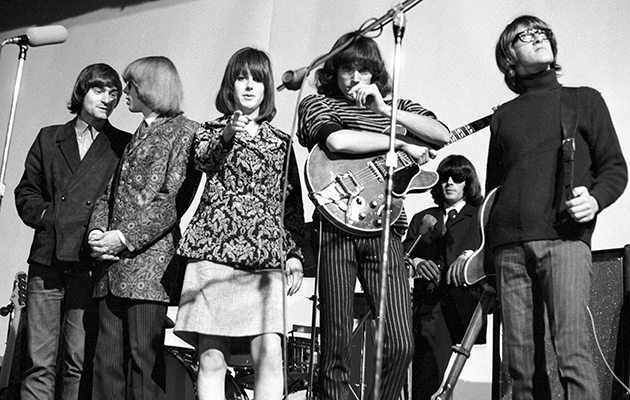Paul Kantner remembers the first time he met Marty Balin. It was spring 1965, and Kantner was playing at a San Francisco folk club, the Drinking Gourd. “Marty came up to me and asked if I wanted to form a band. It was as simple as a stranger asking me that.” For the rest of the decade, Jefferson Airplane were psychedelic pioneers. Guitarist Jorma Kaukonen and bassist Jack Casady were the group’s other constants. “I look back with a good deal of satisfaction at the elegance of what we did,” Kantner considers. “I look at it as being like Columbus or Vasco da Gama, exploring the world, having ups and downs, on a white-water raft. That’s what we did, and we got away with it.” Interviews: Nick Hasted. Originally published in Uncut’s March 2014 issue (Take 202).
__________________________
JEFFERSON AIRPLANE TAKES OFF
RCA, 1966
The Airplane become the first San Francisco Sound band to sign to a major and release an album. Future Moby Grape co-founder Skip Spence is, briefly, their drummer.
PAUL KANTNER: We thought of ourselves as folk musicians. I was greatly influenced by The Weavers, they taught me about three-part harmonies, and most importantly, having an extremely powerful female singer in my bands. And that served me well. We were all folkies. But all of our albums were different.
JORMA KAUKONEN: Most of us came from very different musical backgrounds, but were united in the goal of making music. …Takes Off was a real folk-rock album. It was recorded on a three-track machine, which was like the Starship Enterprise to us then. We were really lucky, as we had all these great singers, like Marty and Signe [Toly Anderson]. She wasn’t funky by any stretch of the imagination, but she had a great, powerful voice. She got pregnant and wanted to start a family and went off to do that. Skip wasn’t a drummer, he was a guitar player. Marty and Paul bagged Skip because they liked the way he looked. He was blond and he had bangs. Marty never told anybody what to play. But we all looked to him as the leader at that time.
JACK CASADY: We came into that with material we’d played live, and we recorded it that way. Our audiences were in the San Francisco area, which had this small community feel. The Charlatans were starting out, and Sopwith Camel, and The Warlocks, who became the Grateful Dead, and Quicksilver Messenger Service. A lot of them moved from the folk world to plugging in.
__________________________
SURREALISTIC PILLOW
RCA, 1967
Grace Slick joins the band, helping to define the band’s sound – and their place in the culture – with “Somebody To Love” and “White Rabbit”.
KANTNER: Marty was a big factor in that. He came out with a whole bunch of great love songs so easily, and they’re real, and they have emotion in them.
CASADY: When Signe left, Paul wanted another female singer, and after a Great Society show, I asked Grace [Slick], “Would you come over one afternoon and sing a couple of songs with us?” And it worked out. We were starting to expand the group’s tonal sound. That was a real breakthrough for us in the studio.
KAUKONEN: Surrealistic Pillow really is a rock’n’roll album of that time. We did it in 10 or 11 days. And Grace brought two iconic songs, “White Rabbit” and “Somebody To Love”, and those two songs are the reason we’re in the Rock And Roll Hall Of Fame. Nobody sounded like Grace back then, and she was also, to put it mildly, not a conservative person. The music was inextricably entwined with the culture around us. Back in those days, San Francisco was a small town. The magic was that the music was able to escape its boundaries and be heard elsewhere. But we were playing to the home crowd. We were talking to our peers, and to the people that mattered to us.
KANTNER: The point of “White Rabbit” was to put stuff into your head that you might like to consider that is good for you. That’s what “feed your head” is about, in my opinion – joy, passion, bliss. And unfortunately too many believed it, and all these people came here to San Francisco in the summer and fucked everything up!



